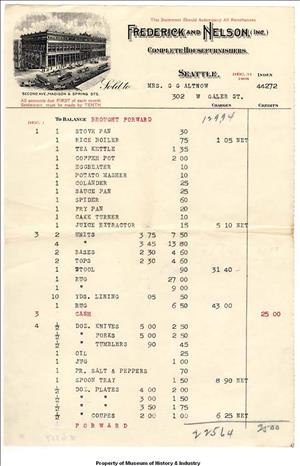This history of the Frederick & Nelson Department Store is by Gordon Padelford, age 13 at this writing (May 2002). Gordon Padelford is the great grandson of the founder of the store, Donald Edward Frederick (1860-1937).
Frederick and Nelson
I will tell you about the development of the Frederick & Nelson department store, the business that was a major part in Donald Edward Frederick's life. After arriving in Seattle in 1890, Frederick found a friend from Colorado, James Mecham, and they started a "second hand household furnishings business." A few months later another Colorado friend came, Nels B. Nelson who bought a one third share of Frederick and Mecham's business. After the business moved into a car barn, Mecham sold out of the business.
Frederick and Nelson set out to make a great store and were a unique team. Frederick had a "keen instinct for merchandising and a high regard for service." Mecham had said, "endowed by the Creator with an unusually brilliant mind, and with an unswerving purpose and moral courage to do, at all times, the right as he saw it. He was a bundle of dynamic energy and every hair of his red head radiated energy to those about him." The team was complimented by Nelson's hard work and after all he was "truly one of God's noblemen" according to Mecham.
Frederick and Nelson grew with Seattle and in 1891 acquired the Queen City Furniture Company located on 2nd Avenue between Seneca and Spring streets. They moved again to 1213-1215 2nd Avenue when 1891 was coming to a close.
The furniture business was necessary to the survival of the firm and Frederick seemed to have a gift for that too. For example one night Nelson went into the room above the store that he and Frederick shared and discovered his bed was absent. When inquired about it, Frederick replied, "A customer wanted to buy it, so I sold it to him." Also Frederick and Nelson were some of the first people to let customers pay off a purchase in installments, which brought in more customers.
The Alaskan gold rush brought even more customers and soon they needed more room for all of their items so they bought the Pacific Carpet Company in 1897 and consolidated their firm with Silas Munro who owned the New England Furniture Company. Now the company was Frederick, Nelson, and Munro. They took over the storefronts from 1213 to 1223 2nd Avenue before they moved again in 1897 to 2nd Avenue and Madison Street.
They leased both floors of the building and installed a rare novelty, an elevator. Frederick and Nelson encouraged Native Americans to sell their goods outside the store, which encouraged people to come and look around. They soon installed a mail-order system; and if a desired item was not in their shop, Frederick and Nelson would buy it from some other store. Their business was quickly developing into a department store.
Munro was taken out of the picture when in 1900 they were offered a lease of Schram Hardware's corner. Munro said that he thought the company could not grow any bigger because the gold rush was slowing down, but Frederick and Nelson with their nature bought him out and purchased the lease anyway.
D.E. (as Frederick was known) also added many popular things to make the store more appealing. By the early 1900's Frederick and Nelson had a big delivery fleet that would grow over time. The delivery carriages then later automobiles, would bring anything from a room full of furniture to one spool of thread to your house if you asked; truly the single spool of thread was brought to an old lady's house in one of the delivery trucks carrying nothing else. In 1903, a popular attraction was added, a tearoom. Ready to wear clothes were on display, and that was a fairly new concept around the turn of the century.
In 1907 Frederick received word that Nels Nelson had died at sea while returning from a stay at a medical spa in Bohemia. He was greatly shocked by this and people say he was never the same. After the tragedy, studying the expansion of the city, Frederick bought the entire block on Pine between 5th and 6th avenues, which was met with surprise because no stores were really out there. The originally six-story building was started in 1916 and took two years to build.
Frederick & Nelson had Seattle grow up around it through the good times and bad. The store remained there, adding a great Santa Claus and a Frango candy plant after the business was sold to Marshall Fields in 1929. While Marshall Fields owned the business they leased the building from my family so when the retail business went bankrupt, my extended family regained the building. The building was sold to Nordstrom's in 1996.
Frederick died in 1937 and was deeply admired by the business industry. Thank you for reading this story and for more on Frederick check out the Donald Edward Frederick biography.

